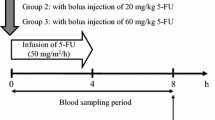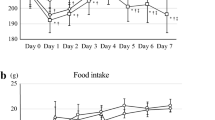Summary
The pharmacokinetics of l-(tetrahydro-2-furanyl)-5-fluorouracil (FT) and its conversion into 5-fluorouracil (FUra) in liver tissue were studied in ten patients with hepatocellular carcinoma (HCC). The plasma concentration of FT after its intravenous injection (dosage: 800 mg) was computerfitted to a biexponential function (C= Ae-αt Be-βt), indicating a two-compartment disposition. The pharmacokinetic parameters did not significantly differ between the five patients with, and the five without cirrhosis of the liver. The plasma concentrations of FUra likewise showed no significant difference between the two groups.
The rates of FT degradation in the liver tissue homogenate were similar for four of the patients with cirrhosis (0.10 ± 0.05 μmol/g liver protein/30 min) and four of those without it (0.13 ±0.05). The rates of cytochrome P-450-dependent FUra formation in the microsomal fraction of liver tissue from two patients (1.1 and 1.3 nmol/mg microsomal protein/30 min) were dramatically reduced to less than half of those of two control subjects (2.4 and 2.7). The estimated rates of FUra formation in the soluble fraction (105,000 × g supernatant fraction) from the two patients (0.1 and 0.13 nmol/mg protein/30 min) were almost identical to those from the controls (0.12 and 0.14), suggesting that the rate in the soluble fraction from HCC patients may not be as strongly affected as the rate in the microsomal fraction. The soluble fraction-catalyzed rates per gram of liver protein in the two patients (58 and 67 nmol/g liver protein/30 min) were approximately twice the microsomal fraction-catalyzed rates (28.1 and 34.0), while the former rates in the controls (73 and 76) were very similar to the latter (72.5 and 84.9). These findings suggest that the soluble fraction accounts for a major portion of the capacity for converting FT to FUra in the liver of HCC patients.
Similar content being viewed by others
References
Blokhina NG, et al: Results of treatment of malignant tumors with fetorafur. Cancer 30: 390, 1972
Karev NI, et al: Experience with ftorafur treatment in breast cancer. Neoplasma 19: 347, 1972
Valdivieso M, et al: Clinical evaluation of Ftorafur (pyrimidine-deoxyribose N1-2′-furanidyl-5-fluorouracil). Cancer 36: 1821, 1976
Cohen AM, et al: The disposition of ftprafur in rats after intravenous administration. Drug Metab Dispos 3: 303, 1975
Fujita H, et al: Pharmacokinetics of Ftorafur (FT-207) for a clinical application. Ninth International Congress on Chemotherapy, London, 1975
Ohira S, et al: Experimental approach to increase the effect of cancer chemotherapy in tumor-bearing rats pretreated with an inducer on microsomal drugmetabolizing enzyme (cytochrome P-450). Ninth International Congress of Chemotherapy, London, 1975
Yusumoto Y, et al: Studies of antitumor agents. I. Resolution of racemic l-(tetrahydro-2-furanyl)-5-fluorouracil into the R and S isomers and examination of the biological activities of the isomers. J Med Chem 20: 1592, 1977
Toide H, et al: Comparative studies on the metabolism of 2(tetrahydrofuranyl)-5-fluorouracil and 5-fluorouracil. Gann 68: 533, 1977
Au JL, et al: Activation of Ftorafur (R, S-1-(tetrahydro-2-furanyl)-5-fluorouracil) and γ-butyrolactone. Cancer Res 40: 2814, 1980
Sayed YME, et al: Metabolic activation of Ftorafur (r, s-(tetrahydro-2-furanyl)-5-fluorouracil): the microsomal oxidative pathway. Biochem Pharmacol 31: 3006, 1982
Fujita H, et al:In vitro distribution and metabolism of N-(2-tetrahydrofuranyl)-5-fluorouracil (FT-207), in “Progress in Chemotherapy (Antibacterial, Antiviral, Antineoplast) by Daikos GK. Athens Hellinis Society for Chemotherapy, Athens, 1974, p 159
Kawata S, et al: Cytochrome P-450-dependent oxidative cleavage of l-(tetrahydro-2-furanyl)-5-fluorouracil to 5-fluorouracil. Jpn J Pharmacol 36: 43, 1984
Okuda K, et al: Primary liver cancers in Japan. Cancer 45: 2663, 1980
Appelqvist P, et al: Primary carcinoma of the liver: Clinical course and therapeutic results. J Surg Oncol 21: 87, 1982
Kato R, et al: Drug metabolism in tumor-bearing rats. I. Activities of NADPH-linked electron transport and durg metabolizing enzyme system in liver microsomes of tumor-bearing rats. Jpn J Pharmacol 18: 224, 1968
Schacter AB, et al: Alterations in hepatic and splenic microsomal electron transport system components, drug metabolism, heme oxygenase activity, and cytochrome P-450 turnover in Murphy-Sturm lymphosarcoma-bearingrats. Cancer Res 42: 3557, 1982
Benvenuto JA, et al: Disposition and metabolism of 1-(tetrahydro-2-furanyl)-5-fluorouracil (Ftorafur) in humans. Cancer Res 38: 3867, 1978
Loo TL, et al Metabolism and disposition of Baker’s antifolate (NSC-139105), Ftorafur (NSC-148958), and dichlorallyl lawsone (NSC-126771) in man. Durg Metabolism Reviews 8: 137, 1978
Au JL, et al: Pharmacokinetics and metabolism of ftorafur in man. Cancer Treat Rep 63: 343, 1975
Au JL, et al: g-Fluorouracil concentrations in human plasma following R, S-1-(tetrahydro-2-furanyl)-5-fluorouracil (ftorafur) administration. Cancer Res 39: 4289, 1979
Henderson JM, et al: Measurement of liver and spleen volume by computed tomography. Assessment of reproducibility and changes found following a selective distal splenorenal shunt. Radiology 141: 525, 1981
Heymsfield SB, et al: Accurate measurement of liver, kidney, and spleen volume and mass by computerized axial tomography. Ann Intern Med 90: 185, 1979
Omura T, et al: The carbon monoxide-binding pigment of liver microsomes. I. Evidence for its hemoprotein nature. J Biol Chem 239: 2370, 1964
Lowry OH, et al: Protein measurement with the Folin phenol reagent. J Biol Chem 193: 265, 1951
Marunaka T, et al: High pressure liquid Chromatographic determination of ftorafur (l-(tetrahydro-2-furanyl)-5-fluorouracil) and GLC-mass spectrometric determination of 5-fluorouracil and uracil in biological materials after oral administration of uracil plus ftorafur. J Pharm Sci 69: 1296, 1980
Marunaka T, et al: Analysis of pyrimidine bases in biological materials by gas chromatography-mass spectrometry. J Chromatogr 190: 107, 1980
Fujii S, et al: Effect of uracil and its derivatives of antitumor activity of 5-fluorouracil and l-(2-tetrahydrofuranyl)-5fluorouracil. Gann 69: 763, 1978
Fujii S, et al: Effect of coadministration of uracil or cytosine on the antitumor activity of clinical doses of l-(2tetrahydrofuranyl)-5fluorouracil and level of 5-fluorouracil in rodents. Gann 70: 209, 1979
Hills EB, et al: GLC determination for ftorafur in biological fluid. J Pharm Sci 66: 1497, 1977
Author information
Authors and Affiliations
Rights and permissions
About this article
Cite this article
Kawata, S., Noda, S., Imai, Y. et al. Hepatic conversion of 1-(tetrahydro-2-furanyl)-5-fluorouracil into 5-fluorouracil in patients with hepatocellular carcinoma. Gastroenterol Jpn 22, 55–62 (1987). https://doi.org/10.1007/BF02806335
Received:
Accepted:
Issue Date:
DOI: https://doi.org/10.1007/BF02806335




